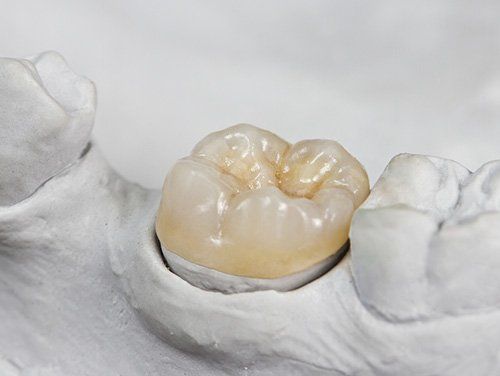The first step is ensuring that the tooth to be treated and adjacent teeth and gums are healthy. This is always a smart first step for any cosmetic or restorative treatments. If fillings are needed or there is any sign of gum disease, these situations should be addressed before the crown is manufactured and placed.
Your crown placement begins with trimming the tooth to be crowned. This process is needed to reduce the size of that tooth slightly so the additional bulk of the crown will fit between adjacent teeth and allow your upper and lower teeth to fit together the right way. Your tooth and gums will be numbed before this shaping starts.
If there is any decay in this tooth, that must be corrected as part of this step. If this correction results in a tooth not being large enough for a crown to be cemented to it, Dr. Murphy will need to build up the size of the tooth before any additional work is done. He will use the same composite resin that is used for tooth-colored fillings to increase the size of the tooth to the dimensions that will secure the crown.
When the natural tooth is the right size and shape, its exact dimensions will be recorded. This recording could be done with impression molds of soft plastic or with a digital process. This impression of the prepared tooth and other teeth around it will guide the manufacture of the ceramic or porcelain crown.
If there is a delay while the final crown is manufactured, Dr. Murphy will give you a temporary crown for your comfort until the final one is ready. You will be scheduled for placement of the permanent crown a week to two weeks later.
When you return, Dr. Murphy will first verify that the new, permanent crown was properly manufactured and make any adjustments needed. When he is satisfied that the crown is exactly right, the temporary crown, which was secured using a removable cement, will be taken off. During this process to remove the old crown and cement on the new one, you normally do not need further numbing.
Dr. Murphy will try the new crown on your tooth, ensuring that the fit over the prepared tooth and with the adjacent teeth is correct. The crown must also meet your opposite teeth in just the right way. If any adjustments need to be made, they will be made at this point, before it is cemented on. The appearance of the tooth should also be just right.
Dr. Murphy may try on and remove the crown several times as he corrects the fit. Finally, when you are both happy with the fit and appearance, he will place the permanent cement inside the crown and fit it firmly over your tooth. A few minutes later, when the cement has begun to set, any excess cement will be trimmed away.

